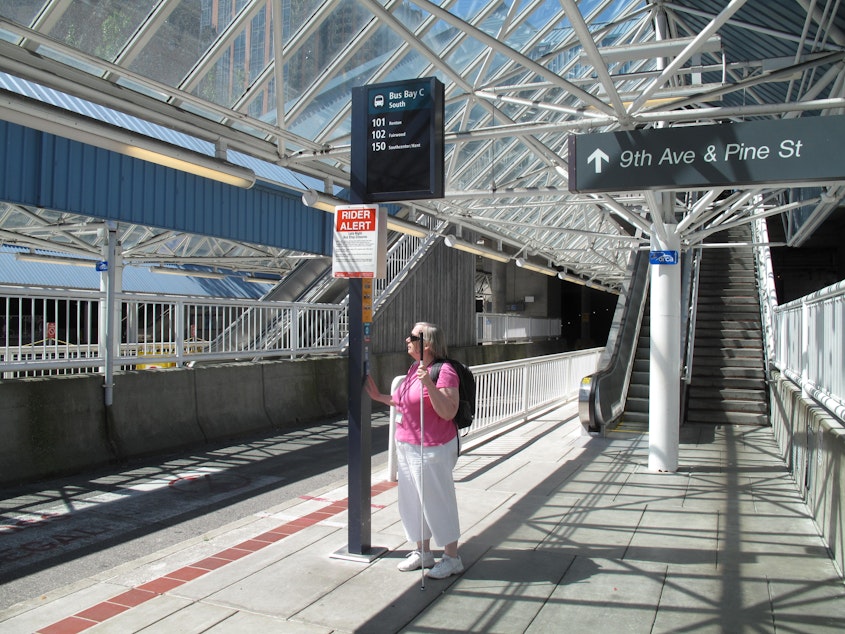Winners and losers when Convention Center expands

Route 150 pulls up to the University Street station in the downtown Seattle transit tunnel. On board, passenger Marci Carpenter listens for her stop.
“When they open the doors I can tell we’re in a tunnel because the sound is kind of echoing off the walls.”
Carpenter is the president of the Washington chapter of the Federation of the Blind and also advises Seattle on transit issues. She is legally blind, so she rides transit every day for work. Next year Carpenter expects her travel time to increase.
“If it takes me 20 minutes longer each way to get to and from somewhere, that’s another 40 to 45 minutes that I can’t be working with a newly blinded person or that I can’t be meeting with city staff people,” Carpenter said.
The cause of the delay is construction. Specifically, though, construction on the new Washington State Convention Center building, planned for the current site of the downtown Metro terminal, known as Convention Place Station, which feeds into the downtown Seattle Transit Tunnel.
Starting as early as September 2018, hundreds of buses a day will be diverted from the tunnel and onto city streets. Buses take approximately 800 trips through the tunnel during a weekday.
Combined with other major infrastructure projects next year, travel times downtown will get less reliable: Bus passengers will see increased delays of two to seven minutes, and other vehicles will be delayed up to seven minutes, according to Metro spokesperson Jeff Switzer.
“It has the potential to be extremely disruptive,” Carpenter said, so she would like construction to wait until light rail to Northgate is ready and can absorb additional demand from north end commuters.
The proposed expansion will cost $1.7 billion in tax dollars and stands to disrupt traffic throughout downtown. Proponents say Seattle will make more money with more conventions, but community groups are asking how the massive public investment can pay off for its neighbors, employees and the city as a whole — not just an influx of out-of-town conventioneers and the businesses they patronize.
On one side of the ledger, proponents expect a boost in out-of-state visitor spending worth $200 a year ($196 million, to be exact) and $35.8 million more in spending by locals.
“It’s an enormous economic piece of the fabric going forward for the health of the city and the vitality of hotels and restaurants,” said Tom Norwalk, president and CEO of Visit Seattle, which markets the city as a destination.
In fact, hotels and restaurants will get 65 percent of that over $232 million in new spending, according to convention center consultants, ECONorthwest.
The money to build the expansion, though, is public money from taxes on hotel guests. Voters don’t get a say in how the money is spent because the law dedicates the taxes to the convention center.
The distribution of that public investment rankles some community groups, such as Puget Sound Sage, which opposes the project.
“The problem for us is when at the end of the day, the people who really have the most power and are brokering the deal are the ones that are going to disproportionately benefit,” said Howard Greenwich, Senior Policy Advisor. “That's the surrounding hotels and the hotel industry.”
Those hotels and the new building itself will create 2,300 jobs, according to the convention center. But most of the new jobs will have low wages and no benefits, boosting the city’s need for affordable housing, said Stefan Moritz with the Unite Here Local 8 hospitality union. Instead, the union views the project as an opportunity to raise labor standards for hotel workers.
“I think the city has to look really hard at whether the project is in the public interest and provides enough public benefit.”
I put that concern — that the project disproportionately benefits hotels and restaurants — to convention center board chairman, Frank Finneran.
“I'm not sure that that's to the benefit of the public except in so far as the economic vitality of the neighborhood,” Finneran said. “The neighborhood will work economically because there will be people on the street staying in hotels spending money in restaurants and retail stores.”
The convention center’s mission is to generate “economic activity” from out-of-town visitors, he said.
Similarly, neighborhood vitality and economic opportunity is what some locals are worried about, too. Except community groups, calling themselves the Community Package Coalition, are pushing for the benefits to extend more broadly.
“We want to leave a legacy of positive long-term improvement, that is not just the building,” said Alex Hudson, executive director of the First Hill Improvement Association, a member of the Community Package Coalition. “It’s the spaces in between the building, and the people who occupy them; that’s what a city is.”
Members of the coalition are making their presence known at public meetings and in letters to city officials. At the May convention center board meeting, coalition member Scott Bonjukian of Lid I-5 read prepared remarks on behalf of the coalition.
“We are eager to support this project as a coalition, but if and only if you offer commensurate public benefits for our neighborhood and for our city,” he said.
The coalition is asking for around $77 million in affordable housing, better streets and bike lanes, as part of the project.
“It’s public land and public money and we should expect the highest value out of it,” Hudson said.
The project still faces a succession of hurdles in city and county government before it can break ground. The start of construction is slipping back, from November 2017 to January 2018. Meanwhile, community voices in opposition are getting louder.

